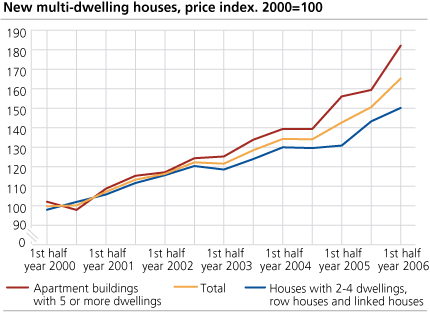Content
Published:
This is an archived release.
Prices of new flats up 16.7 per cent
Prices of new multi-dwelling houses increased by 15.8 per cent from the first half of 2005 to the first half of 2006. Prices of blocks of flats increased the most, by 16.7 per cent, while prices of small houses went up 14.7 per cent in the same period.
From the first half of 2000 to the first half of 2006, prices of multi-dwelling houses have increased by 65.6 per cent. Prices of blocks of flats have increased by 78.5 per cent, while prices of small houses have increased by 53.3 per cent.
Prices of second-hand flats and row houses rose by 65.2 and 63.1 per cent from the first quarter of 2000 to the second quarter of 2006, according to the house price index from Statistics Norway. In comparison, the consumer price index increased by 12.7 per cent in the same period.
Revised figures
Due to a change in method calculating the price index, Statistics Norway has decided to revise previous published figures. The revised figures only show small deviation from earlier published figures.
|
Data source
The Norwegian State Housing Bank provides the data used in this index. The data are based on information from loan applications received by the bank. The index only includes projects for which loans have been granted. Houses are divided into two different groups of buildings: Small houses comprise row houses, linked houses, atrium houses, terraced houses, houses with two, three or four dwellings and other multi-dwelling houses with less than three storeys. Blocks of flats comprise multi-dwelling houses with three or more storeys
Analysis
The method used in the calculation of the index, has been revised in 2006. Each multi-dwelling project is now weighted according to the number of dwellings in the project. The index is calculated using the weighted geometric mean of the prices, adjusted for changes in the weighted values of the characteristics of the buildings. The independent variables are also changed. We now use the total utility floor space per dwelling (both living space and share of communal space). Efforts intended to lower the use of energy required in the dwellings by 20 per cent or more are now included as a characteristic of the building. Sub-indices for two different housing types are calculated using the hedonic method. The sub-indices are weighted into an index for all multi-dwelling houses. The weights are the proportion of dwellings built per housing type during the last three years. The weights are based on Statistics Norway's Building statistics , and are updated annually.
Price
The price used in the index is the price that the final owner has to pay for the dwelling, excluding the cost of the land. Prices are based on loan applications and are estimates of the final costs, not the actual final cost. Comparisons reveal insignificant differences between the estimates of the final costs and the final costs.
Time of measurement
The index is comprised of multi-dwelling housing projects for which the Norwegian State Housing Bank has granted loans during the six-month reference period. Loans are normally granted before or when the building commences. |
Tables:
Contact
-
Statistics Norway's Information Centre
E-mail: informasjon@ssb.no
tel.: (+47) 21 09 46 42

